What you should know about wood flooring?
Wood floors are the standard flooring in almost any interior; they add warmth, beauty and value to any home. They last far longer than any other flooring and if they get scratched, dented or severely tested, they can always be sanded and refinished to look like new again. Wood floors have seen tremendous growth in the past two decades and manufacturers have come a long way introducing new species, styles, colors and even new finishes that made them more durable, affordable and easier to install. Here are a few things you need to know prior to purchasing your wood floor.
THE LOOK:
Wood floors are a product created by nature and their inherent beauty stems from the fact that each plank is unique in both grain and color. It's this uniqueness that gives each species of wood a look that makes it different from all other species. Looking at a small sample may never give you the complete look of the floor; that's why it's always better to look at a room scene and if possible ask for a few samples to get as much understanding of the color and grain variations as possible.
THE GRADE:
Wood floors have three main grades; Select, #1 common and #2 Common. This is a major factor to look for when deciding on a floor since the grade usually defines the look of your floor and in most cases, the entire décor of your home. Here are the main differences between those grades:
Select & Better Grade:
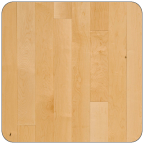
Select grade floors look clean and uniformed. They have the least amount of mineral imperfections, streaks and usually have no knots.
They are cut from the centre of the tree which produces long length planks. This grade is usually the most expensive but not the most popular because of its lack of character. Most manufacturers offer select grade flooring in its natural color.
Natural/#1 Common Grade:
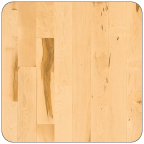
#1 common grade has a good character reflecting from the color variations and small to medium knots on a good portion of its planks.
It is widely used for its unique look and strong presence that compliments every other color in the room. Canadian manufacturers call this grade "Pacific" and it's widely used by almost all mills especially for their stained products. The price varies by brand but is usually affordable.
Rustic/#2 Common Grade:
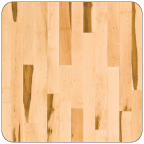
#2 common grade; also referred to as Rustic or character grade; is the most common in country homes and cabins as well as with handscraped or wire brushed flooring. Its strong variations in colors and wide knots make a presence that hardly ever goes unnoticed.
The planks are usually short in length with a maximum range of 60" but some naturally rustic tree like Hickory may produce long planks.
DURABILITY & HARDNESS:
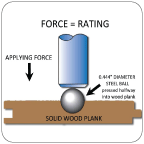
Wood species differ dramatically when it comes to durability. Depending on your living conditions and how many people live or will reside in your home; you should always consider a floor that will stand the amount of traffic you expect in your house or office. If you have pets for example, an open grain wood like Oak or Brazilian Cherry would be your best option. Look for the Janka hardness scale which defines the durability of every species and always give as much information about your living condition to the sales rep so they're able to advise you on your best option. Exotic species are harder, more durable and in some cases cost less than domestic species. If you're not sure, call us at 1-800-674-8088, we are always happy to help.
CLEAR vs STAIN FINISH:
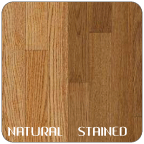
Most wood floors are offered with either a clear finish or a color stain. Clear finishes have become extremely popular since what you see is the natural color of the wood species. It is very suitable for wood species that are colorful by natural like Cherry, Mahogany or walnut. Color stains are usually applied over Oak, Birch or Maple from a variety of popular charts offered by every manufacturer. Scratches and dents are usually more visible on a stained floor especially if the stain is relatively darker than the natural color of the wood species.
COLOR CHANGE OVER TIME:
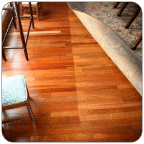
Most wood species mature and change over time to a darker tone: some more than the others. Exotic woods are a good example of this change. Brazilian Cherry for example changes from a light caramel tone into dark reddish/brown. Don't be alarmed if the floor you chose is lighter than the sample you saw in a showroom, most retail samples have already aged and darkened. If this is a concern, ask for a sample from a box and compare the color before you purchase your floor.
TIP: You should also know that you can not place area rugs over exotic woods especially right after the installation. The wood underneath the rug will remain light and may never darken enough to match the rest of your floor.
SOLID vs ENGINEERED:
Wood floors have come a long way in the past two decades presenting new styles that can be installed in areas where wood could never be installed before. Here's a breakdown of all wood flooring types:
- Solid Hardwood: Click to see available brands
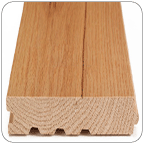
Traditional solid 3/4" hardwood is normally installed on or above grade. It is usually nailed down to a wood sub-floor but is now offered in various thicknesses that may be glued down as well.
Solid hardwood floors expand and contract with the change of the atmosphere and react to high levels of moisture so be sure your installer checks the moisture level prior to installation on both the wood and sub-floor.
- Engineered Planks: Click to see available brands
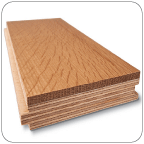
Engineered planks are structured with several criss-crossed plies and topped with a solid hardwood wear layer or in some cases a think veneer layer. This process reduces expansion and contraction so the planks can be installed directly over concrete or in places where solid hardwood may not be suitable.
Engineered planks can be stapled or glued depending on the sub-floor. While some engineered floors may not be sanded and refinished, several mills have produced engineered floors with top layers ranging from 1/8" to 1/4" that can be sanded and refinished as many time as solid hardwood floors.
- Floating Planks: Click to see available brands
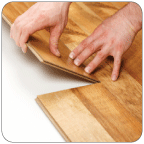
Floating floors are a new innovation presented almost a decade ago. The planks simply interlock to each other creating a floor that is neither nailed nor glued to the subfloor.
Floating floors must be installed over underlayment, require minimal preparations to the sub-floor and can be installed virtually on any solid surface including hardwood, concrete, ceramic, stone and vinyl; they are the sound choice for radiant heat as well. Depending on the top wear layer, floating floors can also be sanded and refinished in the future; just like solid hardwood floors.
Other Types of Hard Surface Floors:
There are a few other types of natural and wood look-alike floors that have been around for quite sometime including laminate, vinyl & cork.
- Laminated Floors: Click to see available brands
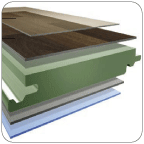
Laminated floors are an economical choice for a durable, cost-effective, scratch-resistant and easy to install flooring. They have become very popular in the past few years. They can be installed virtually anywhere and have reached AC4 and AC5 ratings that allows them to be installed in heavy residential or commercial applications. Laminate floors are constructed mainly of three layers. The bottom layer is usually made of a Formica sheet. The middle layer is made of high density moisture resistant HDF (high Density Fiber) board. The top layer is simply a picture simulating real wood or tile look and is usually coated with several acrylic or Aluminum Oxide finish. Laminated floors come in various shapes and styles and are very suitable for DIY and quick renovations.
- Cork Floors: Click to see available brands
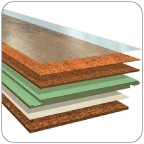
Cork is made of the outer bark layer of an oak tree that grows mainly in the Mediterranean region, especially Portugal. It is sound proof, fire retardant, moisture resistant and best of all; they make the #1 eco-friendly flooring. It is the one floor that can not be dented or scratched with normal household use and is extremely comfortable under foot. Cork flooring is usually available in either square tile that can be glued down to any solid surface or as a Clic 'N' Loc floating floor for higher LEED credits and easier, cleaner installation that does not even require underlayment. Some Clic 'N' Loc cork floors require annual or semi-annual sealing to avoid water seeping through the seams and inflating the HDF board especially in kitchens..
- Vinyl Floors: Click to see available brands
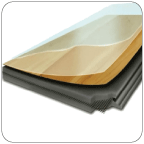
Vinyl floors are made of resins and filler materials that create resilient planks or tiles. They are usually ideal for any surface regardless of moisture or humidity levels and can be installed virtually anywhere. Vinyl floors are naturally sound absorbent and moisture barriers and can take heavy commercial abuse. They are healthy, non-allergenic, and extremely easy to clean. They can be waxed and refreshed with very minimal work. Vinyl floors have seen a tremendous advancement in the past fifty years and are now available in various shapes, styles, colors and construction.
PLAIN-SAWN vs QUARTER-SAWN:
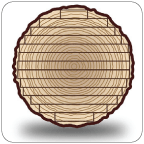
Plain-Sawn hardwood is the most straightforward way to cut rectangular-profiled boards out of a round log. Sawmills create this lumber by making a series of parallel cuts in a log.
This system of cutting wood provides excellent yield because it minimizes scrap. What matters to you in this case is look of the floor. This means the wood grain is comprised of a series of concentric rings beginning in the center. Straight sawn boards have substantially different grain patterns depending on where they were cut out of the log. This does not mean variation in color between the cut boards but rather variation in the way each board looks.
Most hardwood floors are straight-sawn milled. The expansion and contraction of the wood is horizontal and in turn, the amount of expansion is much higher becasue the flooring planks expand side to side. In a 10' wide room, you will have 24 boards expanding sideways. This is the main rerason your installer should leave 1/2" gap between the floor & the wall.
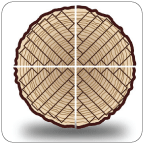
Quarter-Sawn boards are created by first cutting a log into quarters and then creating a series of parallel cuts perpendicular to the tree's rings. The yield is not as substantial as in plain-sawn milling but the grain is relatively consistent and most of the boards look very similar.
Quarter-sawn wood may include medullar rays and wavy grain patterns that some people prefer to the figures that are revealed with straight-sawn. They are always preferred by installers for their stability simply because they expand vertically. In a 10' long room, a quarter-sawn floor will have 2-3 boards from wall to wall expanding vertically which is just a few millimeters. This is why quarter-sawn floors are ideal for radiant heat systems & environments with high moisture levels.
The only down-side of quarter-sawn floors is that they are seldom available; only a few companies offer quarter-sawn floors & in turn very expensive.
NAIL DOWN vs GLUE DOWN:
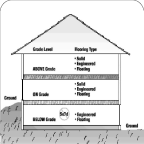
The method of installation is decided by two main factors; where the floor will be installed and the type of sub-floor it will be installed on. There are three main levels in any construction:
- Below Grade (below street level):
Vinyl and floating floors (including engineered and laminated floors) are your best option for this application especially when using a moisture barrier underlayment such as FLOOR MUFFLER. Engineered floors can also be glued down on this level but professional preparation including moisture testing must be done first. Even if your basement has a high level of moisture, simply sealing the concrete with a moisture barrier will allow installing this type of floor.
- On Grade (street level):
The majority of wood floors can be installed on this level but proper testing for moisture is still required especially if there's a basement (finished or unfinished) below.
- Above Grade (second floor and above):
All wood floors can be installed on this level. If you plan to glue down flooring over a concrete slab, please ask your installer to test the moisture of the concrete as well. When gluing solid hardwood, make sure your installer uses moisture cured urethane adhesive such as Sika or DriTac.
Verion Floors offers a wide selection of floors for each of the above applications. Please call us at 1-800-674-8088 if you need advice or have any questions about your floor. We're always here to help.
INSPECTION OF YOUR FLOORS
Once your flooring order is delivered, spare no effort to inspect and verify that it is the floor you purchased. Open at least one box and examine the finish, grade, width and quality of the planks. Make sure your installer is there to check that there are no milling defects. This step will eliminate all unnecessary faults and ensure your project is running smoothly. If the floor is not acceptable; contact us immediately for proper replacement. Do not take chances and install the floor; most manufacturers will not honor any claim of visible milling defects after the floor is already installed.
TIP: The maximum defective or unused wood planks in your order should not exceed the 3% set by the industry standards. This is usually accounted for within the additional 10% waste factor.
KILN-DRYING:
In order to get the lumber dried to a level appropriate for flooring, the lumber typically is dried in a kiln. A kiln is a large oven that provides a controlled environment that removes moisture using a combination of heat and airflow. Temperatures typically range from 100-180 degrees Fahrenheit and help to slowly remove moisture from the wood. Kilns typically dry the lumber down to a moisture content between 6%-9%. Kiln drying also results in sterilizing the wood by destroying insects and fungi. Drying makes wood shrink and adding moisture makes wood swell. These behaviors are related to wood moisture content and how the wood is cut from the tree. To properly understand this process and how wood responds to moisture, it is important to understand the properties of wood moisture content.
MOISTURE:
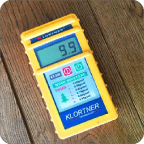
Wood floors are one of the rare building products that inherently showcase the natural beauty of the material itself, which is indicative of why wood has been used as a flooring material for centuries. One of the keys to ensuring a wood floor’s timeless beauty is having a fundamental understanding of the relationship between moisture and wood.
The moisture content of wood is measured as the weight of the water in the wood expressed as a percentage of the weight of the wood itself. The weight of the wood itself is obtained by drying the wood to a point where all of the moisture is removed. This is referred to as oven-dried. Weight, shrinkage, strength and other properties depend in part on the moisture content of wood. In trees, moisture content may be as much as 200%. After harvesting and milling, the wood should be dried to the proper moisture content for its expected end-use. Hardwood flooring in general should have a moisture content between 6% & 9%.
TIP:It is extremely important to check for moisture and humidity level prior to installing hardwood floors on ground levels especially if there's a basement below. Make sure the installer you hire to do the job has the right tools, can test those levels and record them for your peace of mind.
HUMIDITY:
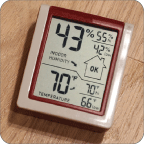
Humidity is important because wood products exchange water molecules from the surrounding air based upon the amount of moisture in the air.
Humidity is the amount of water vapor in the air. Humidity levels are usually higher in colder environment. Just like excessive moisture, excissive humidity can damage your hardwood floor & in turn, it must be kept to a level between 35% & 55% at all timess.
Humidity levels can easily be adjusted simply by adding a humidifier to increase humidity levels or de-humidifier to decrease it.
ACCLIMATION:
The ideal average moisture content for flooring installation can range from extremes of 4-13% depending on many variables, including geographic location and time of year. Additionally, a wide range of conditions can be experienced between individual jobsites in the same locale, such as an ocean-front or lakeside home versus one that’s a few miles inland. Before installation, the flooring product should be identified as being compatible with the area in which it is to be used.
Wood flooring will perform best when the interior environment is controlled to stay within a stable environment and the wood is installed at a moisture content corresponding to those interior conditions. Most wood flooring manufacturers dry their flooring to 6%-9% MC (moisture content), which directly coincides with a relative humidity range of 30-50% and a temperature range 60 to 80 degrees Fahrenheit. This 6-9% range is likely to be the average of all types of wood products used in a normal household environment, assuming common heating and cooling equipment is used to ensure human comfort.
CUPPING & WARPING:
This is not a common occurrence but it does happen; just a few days or weeks after the floor is installed you start to notice cupping (like the bottom half of a circle) or warping (like the top half of a circle). Wood floors cup or warp as the planks react to higher or lower humidity and moisture levels in the room below your floor (usually a basement).
If your floor is cupping, do not panic! It simply means the humidity level below is higher and must be adjusted. De-humidifiers will do the job and the planks will straighten themselves; usually within a few weeks. If the floor is warped, it means the humidity level is lower and that is a problem that maybe fixed by installing humidifiers as well.
SCRACHES & DENTS:
There is not a single species of wood floor that will not dent or scratch, this is a basic FACT you should always be aware of (laminated floors are the best scratch resistant type of floors yet it's not real wood). If someone told you their wood does not scratch or dent, simply walk away.
The beauty about wood floors is that you can always sand and refinish it several times to get a brand new look at a fraction of the cost. However, you can always minimize that effect by following simple procedures: the first thing you need to know is how resistant the wood is to scratching and denting with you living condition. For examples; Oak and Brazilian Cherry can take heavy household abuse without showing scratches and dents because of their open grain characteristics while Maple (even though it's harder than Oak) will show that same abuse immediately because of its smooth, closed grain.
The second is simple, the more you take care of your floor, the better it will always look.
Here are a few tips that will help:
- Once your floor is installed, make sure it's properly vacuumed.
- Place felt pads underneath all your furniture.
- Never drag furniture or sharp objects across the floor.
- Remove any spills immediately.
- Never use bleach, vinegar, oil or excessive water to clean your floor.
- Always use a recommended cleaning system such as BONA.
WARRANTIES:
Flooring warranties usually cover the finish applied to the surface of the wood. It often means that this finish will not wear through, fade or come off during the warranty period.
Several manufacturers also offer structural warranty which refers to the integrity of the wood planks. This structural stability comes from the precision and state of the art kiln drying process.
No manufacturer has ever offered warranty against scratching, denting, cracking, gapping, swelling or any other damage arising from severe household abuse or lack of professional installation even if their floors are certified to be scratch resistant. Please read the manufacturer warranty in full to understand the terms applied to your pre-finished floor. All warranties are posted on the manufacturer's websites or included in their product brochures.
Verion Floors does not offer or extend any extra warranty to any product in our showroom or website, nor can be held liable against any issues arising from or applying to warranty claims. All warranty claims should be taken directly with the manufacturer of your floor. In the case of a warranty claim, Verion Floors will expedite the matter (including filing the claim, supplying all information and following up on the process) between you (the customer) and the manufacturer of your floor until such matter is resolved.
Please call us @ 1-800-674-8088 or Email us for a copy of the warranty offered by any of the brand names we offer.
At Verion Floors, we spare no effort to make sure you are aware of everything you need to know prior to purchasing your floor including hardness, durability, color change, scratching and denting factors as well as all applicable warranties. Our goal is to make you aware of all the facts; when you're aware, your investment with us will always be sound.








